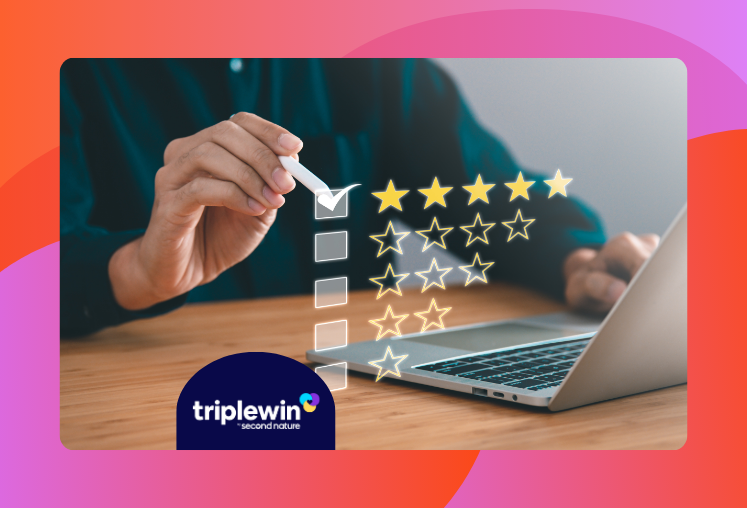Have you heard? We just published our first-ever State of Resident Experience Report!
The report draws fresh insights from the SFR property management industry and explores the three top factors impacting resident experience right now. Download the report to see the results!
In the meantime, today we’re getting started with a related topic: Why is resident experience so important?
Resident Experience is the cumulative effect of all interactions and engagements between a resident and a property management company throughout their leasing lifecycle. It encompasses every touchpoint, from the initial viewing and leasing process all the way to maintenance services, communication, amenities, and lease renewal.
In many ways, the resident experience is the heart of professional property management, encapsulating the quality of living provided beyond just a physical living space.
In this article, we will:
- Explore the paramount importance of resident experience to property management
- Outline how it can directly impact factors like retention rates, profitability, and reputation
- Share insights from leaders in the single-family rental property management industry
Buckle up as we delve into the power of stellar resident experience – and how it’s becoming a strategic imperative in the current real estate landscape.
Here are 8 ways resident experience management can make a difference for residents, investors, and property management companies.

1. Improves Retention Rates
Retention rates, or the ability to keep residents renewing their leases year after year, are a key metric of success for any property management operation. High retention rates mean stable revenue and reduced costs associated with vacancies, marketing for new residents, and turnover maintenance.
But what fuels high retention rates? The answer is an exceptional resident experience & platform. When residents feel heard and valued, they’re a lot more likely to renew their leases. This positive resident engagement is just as important in single-family rentals as it is in multifamily apartment communities, where it often gets more attention.
In essence, the resident experience is your tool to turn the transient nature of renting into a long-term relationship. It's not just about providing a day-to-day place to live; it's about designing a product and service that residents will pay for and stay for.
A truly positive resident experience can convert short-term leases into long-term homes, making it a strategic focus for effective property management.
“I think ten years ago, property managers were only concerned with collecting rent and keeping tenants from doing damage to properties. It was a much more adversarial relationship than it is today. Today, the best PMs know that resident experience is vital to minimizing vacancy and creating a resident that strives to be a higher quality tenant.” - Jonathan Cook, Business Development Manager, Revolution Rental Management
2. Reduces Vacancy Costs
One of the most substantial costs that property managers (and their investor clients) face is the cost of vacancy. Each day a property remains unoccupied equates to lost revenue. Not to mention the additional expenses associated with marketing the property, move-out costs, screening new residents, prepping the move-in process, and preparing the unit for occupancy again. When you add it all up, the costs can be quite significant.
This is basically the flip side of the coin of “resident retention.” Good resident experience → Resident retention → Reduced vacancy costs. A positive resident experience can act as a powerful retention tool, encouraging residents to renew their leases and reducing the churn that leads to vacancies.
“We’ve really started to notice that the better experience we can make with the tenants, the more they want to come to us as opposed to our competitors. It's all about experience. We’ve held onto this idea that we want to provide the experience that residents gravitate to.” - Chenoa Stark, Property Manager at American Leasing and Management
After all, happy residents can become your advocates. They are likely to spread the word about their experience, drawing in potential new residents. By delivering an exceptional resident experience, you're offering them just that, making your property stand out in a crowded market.
3. Increases Profitability
“Property Managers who are on the cutting edge realize that by focusing on the resident experience, they will earn better returns on investment for their company and their investor clients.” - Gregg Cohen, Co-Founder of JWB Real Estate Companies.
A compelling resident experience is a secret weapon for driving profitability in property management. It's like a strategic chess move that not only strengthens your relationship with residents but also contributes to your bottom line in several key ways.
- Reduced Acquisition Costs: We’ve already discussed how, by keeping your current residents happy and renewing, acquisition and move-in costs are drastically reduced.
- Increased Ancillary Revenue Opportunities: A positive resident experience can open the door to various ancillary income opportunities with strategic pricing. Services like an RBP can boost your profitability while simultaneously improving the resident experience.
- Word-of-Mouth Marketing: Satisfied residents are your best brand ambassadors. They can spread positive word-of-mouth about your property, attracting new prospects and reducing marketing expenses.
- Operational Efficiency: Elements that enhance the resident experience, such as digital communication portals or automated maintenance requests, also lead to operational efficiencies. These improvements can streamline and automate processes, saving time and reducing costs.
In essence, a robust resident experience strategy is not just about resident satisfaction; it's a profitability powerhouse. It allows property managers to attract and retain residents more cost-effectively, uncover new revenue opportunities, and operate more efficiently, all of which positively impact the bottom line.
4. Boosts Reputation
In the age of online reviews and social media, reputation is everything, especially in the property management industry. A strong, positive reputation can be one of your most valuable assets, attracting potential residents and providing a competitive edge in the market.
The cornerstone of a great reputation? You know the answer already: An exceptional resident experience.
When residents have positive interactions with your property management team, they're more likely to share their experiences. These shared experiences, whether through word-of-mouth or online reviews, contribute significantly to your company's reputation.
Positive reviews can attract new residents looking for a new home, reducing the time and cost of filling vacancies. They also provide a form of social proof, assuring prospective residents that they're making a good choice by choosing your property.
Furthermore, a stellar reputation can strengthen relationships with investors, vendors, and other stakeholders. It can lead to new business opportunities and partnerships, further boosting profitability.
In essence, cultivating a superior resident experience is like planting the seeds of a robust, positive reputation. As you nurture these experiences, your reputation can grow, reaping benefits in terms of resident attraction and retention, stakeholder relationships, and overall business growth.

5. Simplifies Rent Collection
Rent collection is a critical component of property management, and any strategy that can streamline and improve the efficiency of rent collection is worth its weight in gold. That's where a stellar living experience comes into play.
Satisfied residents are generally more cooperative and timely in fulfilling their financial obligations, including paying rent. Positive relationships between residents and property managers foster a sense of mutual respect and understanding, which can go a long way in ensuring smooth rent collection.
The resident experience also extends to tools and incentives for on-time rent payments. For instance, an easy-to-use online portal for rent payment can lead to faster, more reliable rent payments.
One of the best ways to ensure on-time payments is by providing incentives in a Resident Benefits Package (RBP). An RBP can provide credit reporting for on-time payments, resident rewards for early payments, and more.
A great resident experience doesn't just make residents happier; it makes the fundamental aspect of rent collection easier and more efficient. It's a testament to the idea that good relationships make good business sense.
6. Reduces Maintenance Issues
Maintenance is a significant part of property management, and it can be a substantial cost center. However, by offering a superior resident experience, you can reduce the frequency and severity of these issues.
Residents who feel taken care of are more likely to reciprocate those feelings towards the property.
A positive resident experience can also foster better communication between residents and management. Residents are more likely to report minor maintenance issues promptly before they escalate into major, costly repairs. For instance, a leaky faucet reported and repaired promptly will cost much less than ignoring it until extensive water damage occurs.
Again, one of the best ways to boost resident satisfaction and reduce maintenance costs is to provide a Resident Benefits Package. At Second Nature, our RBP provides things like scheduled filter delivery to ensure air filters are changed on time and reduce HVAC costs.
The mantra is simple – take care of your residents, and they'll take care of your property.
7. Creates Satisfied Investors
Property owners are investors who seek returns on their investments and the preservation of their properties' value. A vital element to achieving this is through offering an exceptional resident experience.
When residents are satisfied, they tend to stay longer, pay rent on time, and take better care of the property. This leads to consistent income, reduced expenses, and fewer maintenance issues — all key elements for maintaining a property's value and ensuring strong returns.
And remember: properties known for their superior resident experience tend to attract quality residents faster, reducing costly vacancy periods. They're also more resilient against market fluctuations, preserving investors' returns.
Property investors value professional property management that focuses on resident experience because it signifies competent handling of their investment. It displays a forward-thinking approach that aligns with today's renter expectations. It leads to a virtuous cycle of high-quality tenancies, stable returns, and preserved property value – a “triple win” for residents, PMCs, and investors.
“When you're giving that great experience to your residents, you're also giving that great experience to your owners. They have less lost vacancy, they have more care and more respect given to their property, and that's going to protect their assets. That shift in the industry is already happening, and those that are able to make that pivot quickly are going to be able to level themselves up and really get ahead of the curve.” - Kelli Segretto, Property Management Inc.
8. Builds Competitive Advantage
“As the operator of a business, how can I get from something transactional to something transformative – so that people are getting something from me that they aren’t getting from most other businesses.” - Jordan Muela, CEO of LeadSimple
In today's competitive property management landscape, offering an exceptional resident experience is not just a perk, it's a differentiator. It's what sets a property management company apart in a crowded market and makes it a preferred choice for residents.
A positive resident experience leads to higher resident retention, reducing vacancy rates and the costs associated with acquiring new residents. It allows property managers to maintain steady rental income, creating a solid financial foundation that competitors might struggle to match.
In a nutshell, a commitment to providing an exceptional resident experience can provide a significant competitive advantage for all the reasons listed above – positioning a property management company as a leader in the field.
How Second Nature Helps Optimize Resident Experience
Second Nature built a product based on the idea that creating a world-class resident experience could make a difference in profitability and value for residents, property managers, and property owners.
We designed a fully managed all-in-one Resident Benefits Package that does just that.
The RBP provides benefits, incentives, and concierge services that residents want to pay for and stay for. It drives up value for everyone involved and delivers a unique and elevated experience.
“A resident benefits package – you hear people call it the easy button. That’s because it is essentially all of these different services and all of these different, valuable add-ons for your residents that are done for you.” - Kelli Segretto, Property Management Inc.
Learn more about the Second Nature RBP, or dig into our 2023 State of Resident Experience Report.
Topics:




